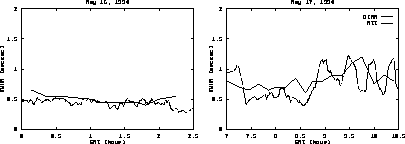



Next: Synthesis
Up: Dome seeing
Previous: Seeing
caused by
It is generally acknowledged among astronomers that the telescopes which
have enclosures that allow for wind ventilation have a low dome
seeing. Unfortunately here also the evidence is mostly anecdotal and
few actual data exist. Even at the NTT which is possibly the best
example of a "ventilated" telescope in operation, multifold reasons and
technical problems have prevented comprehensive measurements of the
local seeing phenomenon over long periods of time.
We can therefore present here only some individual measurements,
obtained in collaboration with S. Ortolani of Padoua Observatory and
M. Sarazin of ESO, which nonetheless illustrate the performance of the
NTT with respect to seeing. Fig.  shows a
comparison of seeing sequences taken at the NTT [Ortolani 94] and the
corresponding measurements at the DIMM telescope
shows a
comparison of seeing sequences taken at the NTT [Ortolani 94] and the
corresponding measurements at the DIMM telescope . The agreement
is very good and shows that the NTT experiences virtually only the
natural seeing. One should note that the sequence of May 16 is one of
exceptionally low natural seeing. In both cases the wind was weak: during the
May 16 sequence it was between 0 and 3 m/s, while during the May 17
sequence it was 4
. The agreement
is very good and shows that the NTT experiences virtually only the
natural seeing. One should note that the sequence of May 16 is one of
exceptionally low natural seeing. In both cases the wind was weak: during the
May 16 sequence it was between 0 and 3 m/s, while during the May 17
sequence it was 4 5 m/s. The primary mirror was about 1 to
2 degrees K colder than ambient air.
5 m/s. The primary mirror was about 1 to
2 degrees K colder than ambient air.

Figure: Comparison of seeing measurements at the NTT and at the DIMM.
However the NTT does not behave always so favorably.
On a previous occasion some seeing measurements which let appear the
presence of mirror seeing
([Ortolani 93]) were taken during
a night in which the primary mirror was significantly warmer than
ambient air (fig.  ). Here the wind was 6
). Here the wind was 6 7 m/s but
was facing the back of the telescope building.
7 m/s but
was facing the back of the telescope building.
The effect of opening/closing the louvers at the back of the
telescope was investigated during a test
run: the flaps were alternatively opened and closed every about
ten minutes.
Although the seeing measured by the DIMM was very variable, the difference of seeing between the
two flaps conditions was very noticeable: see
fig.
was very variable, the difference of seeing between the
two flaps conditions was very noticeable: see
fig.  .
The wind speed was about 7 m/s. When the flaps are closed
the ventilation of the telescope volume is much reduced and
the seeing increases immediately. This conclusion joins much
anecdotal evidence by NTT observers complaining that raising the
windscreen (see fig.
.
The wind speed was about 7 m/s. When the flaps are closed
the ventilation of the telescope volume is much reduced and
the seeing increases immediately. This conclusion joins much
anecdotal evidence by NTT observers complaining that raising the
windscreen (see fig.  ) to maintain a good
guiding performance in windy conditions
often degrades the seeing quality.
) to maintain a good
guiding performance in windy conditions
often degrades the seeing quality.
In conclusion,
even with the limitations due to the scarcity of objective data, the
experience of the NTT brings the following elements of knowledge:
- A ventilated enclosure can provide conditions in which local
seeing is virtually nil.
- Mirror seeing is still present when the primary mirror is warmer
than ambient air.
- Local seeing generally reappears when the ventilation is limited
by the closed louvers and the windscreen.

Figure: Seeing at the NTT versus mirror-air temperature difference.

Figure: Effect of flaps on the seeing at the NTT.




Next: Synthesis
Up: Dome seeing
Previous: Seeing
caused by
Lorenzo Zago, lorenzo.zago@heig-vd.ch,
Mon Nov 6 23:33:14 GMT+0100 1995
 shows a
comparison of seeing sequences taken at the NTT [Ortolani 94] and the
corresponding measurements at the DIMM telescope
shows a
comparison of seeing sequences taken at the NTT [Ortolani 94] and the
corresponding measurements at the DIMM telescope . The agreement
is very good and shows that the NTT experiences virtually only the
natural seeing. One should note that the sequence of May 16 is one of
exceptionally low natural seeing. In both cases the wind was weak: during the
May 16 sequence it was between 0 and 3 m/s, while during the May 17
sequence it was 4
. The agreement
is very good and shows that the NTT experiences virtually only the
natural seeing. One should note that the sequence of May 16 is one of
exceptionally low natural seeing. In both cases the wind was weak: during the
May 16 sequence it was between 0 and 3 m/s, while during the May 17
sequence it was 4 5 m/s. The primary mirror was about 1 to
2 degrees K colder than ambient air.
5 m/s. The primary mirror was about 1 to
2 degrees K colder than ambient air.





 7 m/s but
was facing the back of the telescope building.
7 m/s but
was facing the back of the telescope building.

